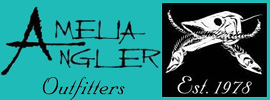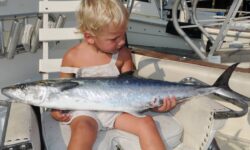March 20th is the first day of spring and also signals the beginning of Amelia Island’s trolling season for a wide variety of pelagic species of saltwater game fish. Traditional spring winds typically blow from the southeast, pushing those welcome warm water edges over near shore fish havens. With the warming water trends, baitfish schools begin to gather at some of Amelia Island’s favorite fish havens offering some of the best fishing of the year.
During early spring, wahoo, tuna, dolphin, sailfish, blue marlin and kingfish can be targeted at Northeast Florida’s “Continental Shelf”, also called the “Big Ledge”. The Big Ledge is located 65-nautical miles offshore of Amelia Island where water depths begin to drop off sharply from 180-1,000 feet of water in less than a mile. An abundance of baitfish including Spanish sardines and flying fish can be found holding at this deep ledge, becoming a main attraction for fast striking game fish species.
Blue water fishermen typically take a 112-degree heading from the St. Mary’s inlet and after arriving at the “Big Ledge”, begin trolling either north or south along the ledge until both game fish and baitfish are located. Excellent signs where striking fish may be caught include flying fish, weed lines, color changes, or a one degree change in the water temperature.
Fifty-pound trolling tackle is recommended while employing a 12-foot section of 200-pound mono leader. Successful trolling lures include the ever popular “Cedar Plug” in the natural color pattern, the “C&H” “Wahoo Whacker” and the “Islander”. Color patterns include black & red, green & black, white & pink and lime & yellow.
Seasoned “Big Ledge” fishermen typically rig large ballyhoo to their plastic lures. The added baitfish gives the lure bulk, a better swimming action and a natural fish smell.
Captain Allen Mills heads up the “Annual Blue Water Shootout” that showcases Amelia Island’s blue water fishery. During the 2010 tournament, seasoned blue water angler Al Nelson’s team “Long Haul” took 1st place honors. Teams are given valuable points for each legal game fish that they weigh in, while billfish points are strictly catch, photograph and release.
“Long Haul’s” blue water catch included a1st place dolphin, 34.26-lbs., 1st place wahoo, 26-lbs. and second place sailfish that tallied enough points to top some fifteen blue water sport fishing boats. The popular event is held annually held in memory of Bo Stevenson, an avid and well liked local fisherman.
As the spring fishing season begins to grow old, warm water eddies begin to push in closer to shore where striking fish can be found at near shore live bottoms. Look for the “Amberjack Hole” fish haven to warm up first with striking fish including amberjack, cobia, king mackerel, Spanish mackerel, barracuda and more. The “Amberjack Hole is located some 18-miles offshore of the St. Mary’s inlet.
In following days, “Haddocks Hideaway” “FC”, “FB”, “RL” and “FA” fish havens will typically begin to show signs of warming water temperatures and excellent trolling action as well.
Northeast Florida’s grouper season reopens on May 1st where gag grouper weighing to 30-pounds will be ready to test your 50-pound terminal bottom fishing tackle. “FA” fish haven is traditionally one of the better fish havens to tangle with excellent eating grouper. Look for big lime rock ledges to hold both good numbers of baitfish and gag grouper as well. Seasoned grouper fishermen prefer to anchor their boat up current of the ledge and fish right on the high side of the ledge with live cigar minnows, menhaden, pinfish, or cut chunks of “Spanish” sardines.
The black sea bass season does not reopen until June 1st.
Amelia Island’s spring fishing season also showcases the annual run of black drum. The Nassau Sports Fishing Association holds an annual black drum tournament where it typically takes an eighty-pound, or larger black drum to win the top prize.
During the 2010, “11th Annual Amelia Island Black Drum Tournament”, James Raysor topped all competitors with his “Big Dog” black drum weighing 83.16-lbs!
Look for some of the best black drum fishing during the spring fishing season to come along “Main Beach”, the tip of the St. Mary’s south jetty rocks and Nassau Sound at the “Breakers”. Black drum are also landed while fishing in the deep waters of the St. Mary’s and Nassau inlets as well. Best black drum baits include conch, large fresh shrimp, or blue crab. A half of a blue crab barbed on a large 9/0 saltwater hooks accounts for many of those super big Northeast Florida black drum.
Backcountry fishermen will find a variety of both river and shallow water game fish willing to take a live bait, lure, or fly. Redfish head the list for backwater game fish and can be found schooling during the falling and the first of the in-coming tide. Look for redfish to hold along the deep sides of oyster bars, creek mouths and deep-sides of boat docks and along jetty rocks.
Best flies for reds include the crab patterns, epoxy spoon and “Clouser Minnows”. The all time favorite lure for redfish, is the ½ ounce gold Johnson spoon, however the Berkley Gulp shrimp barbed to a ¼ ounce jig head is gaining in popularity.
Sea trout can be found along the St. Mary’s rock jetties and deep river channels where they pass along shallow flats and oyster bars. Fish a live shrimp under a traditional trout float, or “Popping” float.
Flounder fishing is also excellent during the spring fishing season during the falling tide. Some of the very best flounder waters include the rocky shoreline beginning at the mouth of Egan’s Creek to Historical Fort Clinch. Bump a ¼ ounce jig rigged to a bullhead minnow, or live finger mullet slowly along the bottom.
If your fishing pleasure is on foot, the George Grady and the Fort Clinch fishing piers offer excellent pier fishing. During the spring, it’s not unusual for fishermen to land black drum weighing from 15 – 40 pounds from these fishy piers!
Without a doubt, the spring fishing season is the best time of year to target trophy size largemouth bass. There are several freshwater rivers located in our small corner of northeast Florida that every spring, give up their share of bass weighing to ten-pounds.
Area freshwater rivers are affected by the tides; add four hours to find the correct tide in the upper reaches of the freshwater rivers.
Some of the best trophy largemouth bass fishing comes during the high tide phases and the first few hours of the falling tide. One of the best fishing techniques for trophy bass continues to be drifting wild shiners under a small float along shoreline cover. Bass lures include the Bomber “Long-A”, gold Rapala and dark colored “Finesse” plastic worms.
Some of the more productive freshwater streams include Lofton, Boggy, Mills, Nassau and both the big and little St Mary’s Rivers.
Crabbing is popular family fun during Amelia Island’s spring fishing season. Tie a chicken part to the end of a long section of kite string, along with a four ounce weight to get the bait down on the bottom. When a slight tug is detected, bring the crab slowly to the surface and net. Keep your crabs alive in a bucket of saltwater until its time to cook them.
For delicious eating, bring a large pot of water to a boil and add crab seasoning. Next, place the live crabs in the pot of boiling water and cook until the crabs turn a bright pink in color. Enjoy!
Non Florida residents sixteen and older will need to purchase a saltwater fishing license when fishing from land, boats, or piers. Florida residents sixteen and older will also need to have a shore fishing license when fishing from land, or piers. This does include crabbing!
For more fishing and charter information, call or contact the Amelia Angler, (904) 321-5090.









